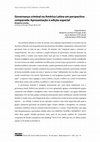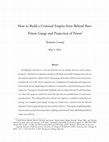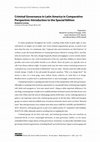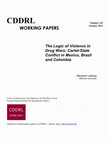Papers by Benjamin Lessing

Dilemas: Revista de Estudos de Conflito e Controle Social
Nas periferias urbanas ao redor do mundo, uma realidade surpreendente se esconde à luz do dia, be... more Nas periferias urbanas ao redor do mundo, uma realidade surpreendente se esconde à luz do dia, bem conhecida, mas em grande parte fora do alcance do público: organizações criminosas locais governam, tanto ou mais do que o Estado. No mínimo, elas "[impõem] regras e restrições ao comportamento" dos civis, conforme a ampla definição de governança criminal oferecida em Lessing (2021), e muitas vezes fazem muito mais que isso. O Estado, embora frequentemente distante e negligente, nunca está totalmente ausente. Os residentes continuam votando, trabalhando em áreas formais da cidade, mandando seus filhos para a escola sempre que possível e recebendo os benefícios públicos oferecidos. Acima de tudo, a polícia geralmente pode entrar à vontade, embora nem sempre sem lutar. Contudo, raramente fica; poucos Estados contestam a governança criminal de forma sustentada, mesmo em meio a "guerras ao crime" militarizadas. Em vez disso, surge um
A Hole at the Center of the State: Prison Gangs and the Limits to Punitive Power
Panel de expertos: Tendencias actuales del crimen transnacional organizado en las Américas
¿Cómo ha evolucionado el crimen organizado en las Américas durante 2018? ¿Cuáles son las principa... more ¿Cómo ha evolucionado el crimen organizado en las Américas durante 2018? ¿Cuáles son las principales tendencias, actores y economías criminales que han sido dominantes durante el año? En este panel analizaremos estos temas e identificaremos los principales acontecimientos criminales del año

Mexico: Conditionality Abandoned
Making Peace in Drug Wars
Mexico has become known for drug violence, which escalated dramatically from 2006 to 2012, includ... more Mexico has become known for drug violence, which escalated dramatically from 2006 to 2012, including a ten-fold intensification of cartel-state conflict. However, large DTOs operated peacefully in Mexico for more than a century. Since its advent in the 1930s, the hegemonic Partido Revolucionario Institucional (PRI) actively managed cartels through a highly conditional state-sponsored protection racket. This system began to erode in the late 1980s and eventually collapsed with Mexico's democratization in the 1990s. Though cartels grew stronger from the 1990s onward due to market forces, the triggering factor for cartel–state conflict—and possibly inter-cartel turf war—was shifts in state policy. This chapter makes four key claims: (1) Under single-party PRI rule (1930s–1989), conditionality was high, leading cartels to eschew anti-state violence. (2) Democratization (1990–2000) weakened conditionality, pushing cartels toward violent strategies, though actual anti-state violence remained rare. (3) Fox's limited, unconditional crackdown (2003–2005) pushed cartels to fight back, triggering the onset of cartel–state conflict. (4) Calderon's massive crackdown (2006–2012) severely reduced conditionality, leading to full-blown cartel–state conflict. I also conjecture that attempts to reform policy in a more conditional direction in 2010 and 2011 mostly failed, but modestly increased conditionality in some repressive agencies. This may have induced some cartels to adopt less confrontational strategies. Under Enrique Pena Nieto, state policy seems to have remained largely unconditional, and cartel–state conflict abides. OVERVIEW Between December 2006, when President Felipe Calderon led Mexico's armed forces into a “war without quarter” against drug cartels, and the end of his term six years later, some 75,000 lives were lost to cartel-related violence. Mexico's drug war began before Calderon's time in office, and has certainly outlived it. Yet Calderon's crackdown and the explosion of violence that followed it both represent radical breaks with the past. What had been a growing but minor concern at the outset of Calderon's presidency became an enduring crisis of national proportions, altering Mexico's perception in the eyes of the world and its own people. Moreover, Calderon's unconditional, militarized approach was quietly adopted by his successor, Enrique Pena Nieto, despite initial vows to reverse course.
Crime in the time of covid-19. How Colombian gangs responded to the pandemic

Replication Data for: Legitimacy in Criminal Governance: Managing a Drug Empire from Behind Bars
Abstract: States, rebels, and mafias all provide governance beyond their core membership; increas... more Abstract: States, rebels, and mafias all provide governance beyond their core membership; increasingly, so do prison gangs. U.S. gangs leverage control over prison life to govern street-level drug markets. Brazil's Primeiro Comando da Capital (PCC) gang goes further, orchestrating paralyzing attacks on urban targets, while imposing a social order throughout slums that sharply reduces homicides. We analyze hundreds of seized PCC documents detailing its drug business and internal disciplinary system. Descriptively, we find: vast, consignment-based trafficking operations whose profits fund collective benefits for members' families; elaborate bureaucratic procedures and recordkeeping; and overwhelmingly nonviolent punishments for debt-nonpayment and misconduct. These features, we argue, reflect a deliberate strategy of creating rational-bureaucratic legitimacy in criminal governance. The PCC's collectivist norms, fair procedures, and meticulous "criminal criminal record...
Explaining Reform Efforts’ Success: Key Factors and Alternative Hypotheses
Making Peace in Drug Wars
The Challenge of Implementing Conditionality

Providing law and order is a core state function; the very attempt, however, can be counterproduc... more Providing law and order is a core state function; the very attempt, however, can be counterproductive. Punishment incapacitates and deters individuals, presumably reducing crime, but can also empower destructive collective forces. Prison gangs, their ranks swelled by mass incarceration, transform the core of the coercive apparatus into a headquarters for organizing and taxing streetlevel criminal activity, supplanting state authority in communities, and orchestrating mass violence and protest. Drawing on a formal model, fieldwork, and case studies from the US and Latin America, I show how gangs use control over prison life, plus the state-provided threat of incarceration, to project power. The model predicts that common state responses—crackdowns and harsher sentencing—can strengthen prison gangs’ leverage over outside actors, consistent with the observed expansion of prison gangs during mass-incarceration initiatives. These gang-strengthening effects ofincarcerationcanhaveincreasin...
Modeling Violent Corruption and Lobbying

Endogenous State Weakness in Violent Democracies : Paramilitaries at the Polls
State weakness can be self-reinforcing through electoral channels. Paramilitaries flourish where ... more State weakness can be self-reinforcing through electoral channels. Paramilitaries flourish where states are incapable of eliminating oppositional foes like insurgencies; paramilitaries can also, we argue, penetrate the state via elections and further weaken it from within. The state may thus tolerate paramilitaries initially, but find itself unable to eliminate them later. Rio de Janeiro’s police-linked milı́cias demonstrate these mechanisms at work. Their domination of hundreds of slums bore political fruit in 2006, when paramilitary leaders and allies were elected state legislators. We exploit the timing of paramilitary expansion, identifying— through difference-in-differences analysis of polling-station returns—a substantial positive effect of territorial domination on paramilitary-aligned candidates’ vote share. Qualitative and quantitative evidence shows that winning allied legislators consistently sought to weaken state repression against paramilitaries, possibly contributing ...

Logics of Violence in Cartel–State Conflict
This chapter introduces the central logics that drive cartels to use violence against the state. ... more This chapter introduces the central logics that drive cartels to use violence against the state. Purely defensive violence to physically reduce losses from state repression is one important logic of violence, but cannot explain cartels’ use of threats, retribution, and terror tactics, all common and clearly coercive in nature. I distinguish two coercive logics by which anti-state violence can influence policy outcomes. In “violent corruption”, cartels use threats of violence against police and other enforcers to induce lax enforcement and more advantageous bribe agreements; in “violent lobbying”, cartels use high-profile, terroristic violence to pressure state leaders into making changes to de jure policy. I summarize the factors favoring each and their predicted empirical footprints. Violent lobbying is subject to collective action problems among cartels, and thus unlikely under conditions of turf war; I present quantitative evidence that it was more salient in Colombia (where cart...

Dilemas: Revista de Estudos de Conflito e Controle Social
In urban peripheries throughout the world, a startling reality hides in plain sight, at once well... more In urban peripheries throughout the world, a startling reality hides in plain sight, at once well-known yet largely out of public view: local criminal organizations govern, as much if not more than the state. At a minimum, they "[impose] rules and restrictions on [the] behavior" of civilians, as per the broad definition of criminal governance offered in Lessing (2021), and they often do much more. The state, though frequently distant and negligent, is never entirely absent. Residents continue to vote, work in formal parts of the city, send their children to school where possible, and receive such public benefits as are offered. Above all, police can typically enter at will, if not always without a fight. Yet police rarely stay; few states contest criminal governance in a sustained way, even in the midst of militarized "wars on crime". Instead, tense but stable modus vivendi emerge. Usually, if you ask people the generic question, "Who is in charge here?" the answer is clear: it's a local gang, mara, milícia, facção, colectivo, or cartel that is in charge. Residents know it, police know it, politicians know it, and, increasingly, researchers know it. Criminal governance is puzzling precisely because of this juxtaposition with state governance. Although it is tempting (and sometimes appropriate) to conceptually lump criminal groups together with rebels and insurgents as "non-state armed actors", doing so elides important differences. For one thing, criminal groups virtually never establish absolute territorial control, and often do not even come close. Police enter the areas in which gangs operate all the time-in fact, reducing exposure to police is one important reason why criminal groups govern in the first place. Rebel and insurgent groups, in contrast, often do establish areas of exclusive territorial control, and it is in these "liberated zones" that rebel governance over civilians most often arises (ARJONA, KASFIR, and MAMPILLY, 2015). Moreover, rebel groups govern as part of an explicit project of "competitive state-building" (KALYVAS, 2006) ultimately aimed at seceding from or toppling the state. Criminal groups do not have such aims, and criminal governance does not constitute an existential threat, or even a meaningful alternative, to state governance. Rather, it is by nature embedded within a larger sphere of state governance. Sometimes, it is physically embedded: many governing criminal organizations, including Brazil's powerful factions, began as prison gangs and
State-building on the Margin: An Urban Experiment in Medellín
AEA Randomized Controlled Trials, 2018
Medellin’s government wanted to raise its efficacy, legitimacy, and control. The city identified ... more Medellin’s government wanted to raise its efficacy, legitimacy, and control. The city identified 80 neighborhoods with weak state presence and competing armed actors. In half, they increased non-police street presence tenfold for two years, offering social services and dispute resolution. In places where the state was initially weakest, the intervention did not work, mainly because the government struggled to deliver on its promises. Where the state began stronger, the government raised opinions of its services and legitimacy. If there are indeed low marginal returns to investing in capacity in the least-governed areas, this could produce increasing returns to state-building.

What Is Cartel–State Conflict?
Making Peace in Drug Wars
This chapter delineates the concept of “cartel–state conflict” and its relationship to other conf... more This chapter delineates the concept of “cartel–state conflict” and its relationship to other conflict types and the theories scholars have advanced to explain them. The militarized drug wars of Colombia, Mexico, and Rio de Janeiro have caused destruction on par with some of the most violent civil wars; the peaks of violence involved both intense fighting among cartels for turf and sustained armed confrontation between cartels and state forces. Nonetheless, cartel–state conflict and inter-cartel turf war are logically and causally distinct conflict types: each can exacerbate the other, but each can also occur in the absence of the other, or in widely differing proportions. Cartel–state conflict is also distinct from civil war, a fact which the popular “criminal insurgency” concept has obfuscated. I present a framework for analysis that distinguishes conflict types by central goals and battle aims; introduces the key logics of violence that operate within each conflict type; and discusses the (imperfect) mapping between conflict types, logics, and observed patterns of violent events, i.e., the “microdynamics of conflict.” FRAMEWORK FOR THE STUDY OF CONFLICT AND CRIMINAL VIOLENCE This chapter delineates the concept of cartel–state conflict: what it is, what it is not, and where it stands in relation to other conflict types and the theories scholars have advanced to explain them. The study of drug war and criminal conflict in general is relatively new and under-theorized, and a dearth of clear concepts has led some scholars to conflate cartel–state conflict with other conflict types, or treat it as a mere by-product. The conceptual brush-clearing undertaken here clarifies the similarities, differences, and potential causal linkages among conflict types, setting the stage for the theory of cartel–state conflict I develop in Chapters 3 and 4 (see also Lessing 2015). In the process, I explain my analytic approach and place it within a framework for the broader study of conflict and criminal violence. The drug trade is a violent business. Though well-known, this fact is quite puzzling: trafficking is based on voluntary economic transactions, and so does not logically require violence. Extant scholarship on drug violence, focused on consumer markets in first-world settings, generally attributes such “systemic violence” to a lack of enforceable contracts and property rights (Goldstein 1985; Skaperdas 2001).
Rio de Janeiro: Conditionality, One Favela at a Time
Making Peace in Drug Wars
Making Peace in Drug Wars: Crackdowns and Cartels in Latin America

Why have militarized interventions to curtail violence by drug cartels had wildly divergent resul... more Why have militarized interventions to curtail violence by drug cartels had wildly divergent results? In the past six years, state crackdowns drove a nine-fold increase in cartel-state violence in Mexico, versus a two-thirds decrease in Brazil. Prevailing analyses of drug wars as a criminal subtype of insurgency provide little traction, because they elide differences in rebels’ and cartels’ aims. Cartels, I argue, fight states not to conquer territory or political control, but to coerce state actors and influence policy outcomes. The empirically predominant channel is violent corruption—threatening enforcers while negotiating bribes. A formal model reveals that greater state repression raises bribe prices, leading cartels to fight back whenever (a) corruption is sufficiently rampant, and (b) repression is insufficiently conditional on cartels’ use of violence. Variation in conditionality helps explain observed outcomes: switching to conditional repression pushed Brazilian cartels int...










Uploads
Papers by Benjamin Lessing